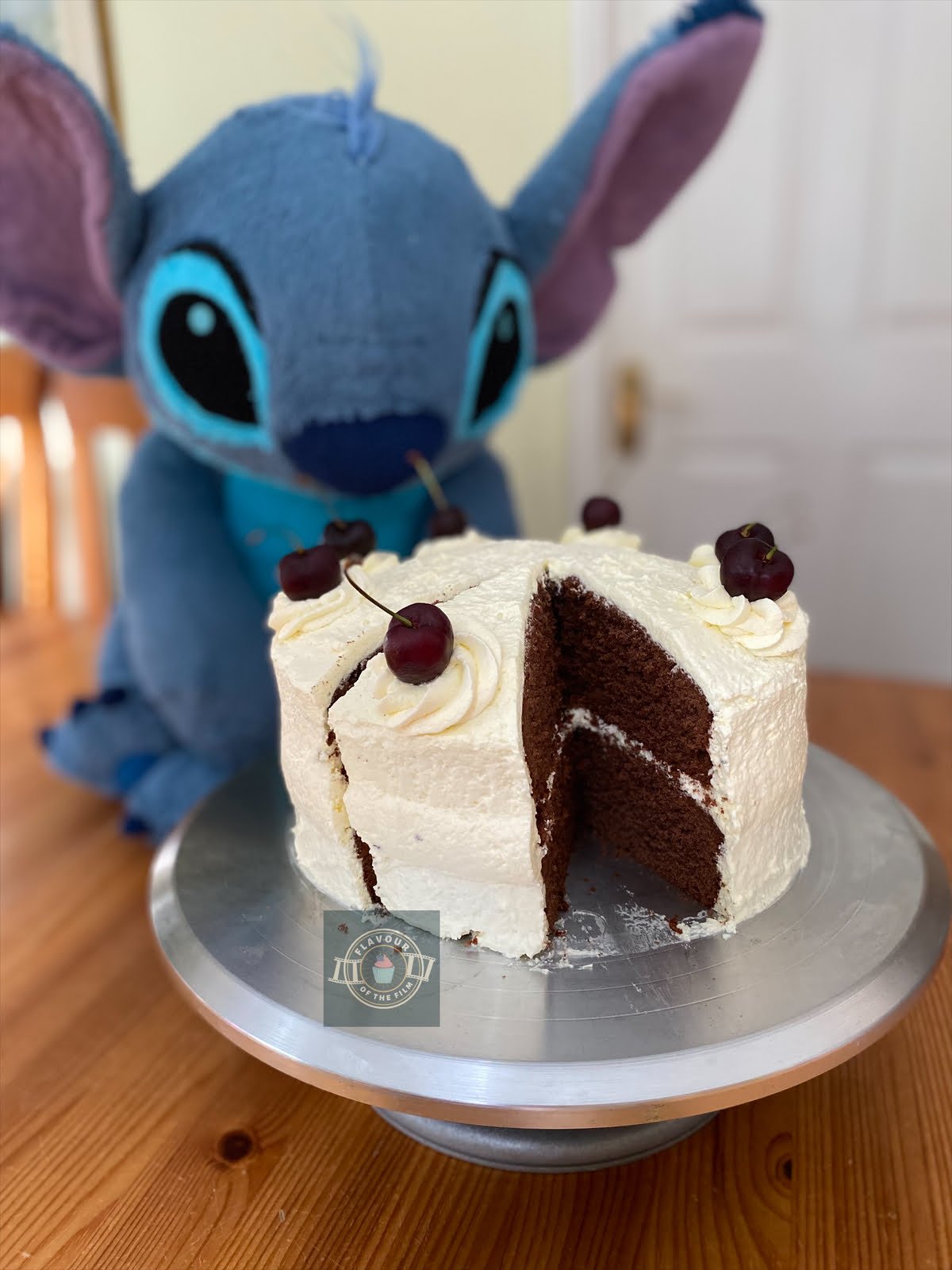
Lilo & Stitch Cake | Lūʻau Dessert Cake
Soft and chocolatey Lūʻau dessert cake with coconut flavoured swiss meringue buttercream and topped with fresh cherries, celebrating Disney's Lilo & Stitch.
Ingredients
Lilo & Stitch cake:
- 400 g [around 6 large] eggs
- 400 g [2 cups] caster sugar
- 400 g [14 oz] unsalted butter
- 325 g [2 cups] self-raising flour
- 75 g [½ cup + 3 tbsp] high quality cocoa powder
Swiss meringue buttercream:
- 4 large egg whites
- 260 g [1 cup + 3 tbsp] granulated sugar
- 230 g [8 oz] unsalted butter cool and cubed
- 2 tsp coconut extract or extract of your choice optional
- Pinch of salt
Decoration:
- 12 fresh cherries stems left on
Instructions
- Preheat your oven to 180°C [350°F] or 160°C fan. Grease and line two 8 inch (20cm) cake tins with greaseproof paper/baking parchment and set aside.
- Weigh out your eggs in their shells until you get as close to 400g as possible. Allow for 20g either way. Whatever weight you end up with, weigh out the rest of your ingredients to this exact number.
- In a large bowl, cream together the sugar and butter until light and fluffy.
- Add the eggs, one at a time, and beat in until fully incorporated.
- Sieve in the flour and cocoa powder and mix in well, until you see no visible lumps.
- Divide evenly between the tins and bake for 40 – 45 minutes. Check after 40 minutes.
- Your sponges will be ready when a skewer/cocktail stick comes out clean, the surface of the sponges bounce back when pressed on, and you hear little to no crackling/bubbling sound when you listen to your cakes.
- Allow the cakes to cool in the tins for around 10 minutes, then transfer upside down to a wire rack to cool completely.
- Whilst your cakes are cooling, make your Swiss meringue buttercream.
- Separate each egg, putting the yolks in one bowl and the whites in a small bowl, then into a large bowl. Good advice would be to pour the egg white into the large bowl every time you separate an egg, so that you don’t risk ruining the whole batch of egg whites if any yolk gets in.
- Whisk the sugar into the egg whites by hand briefly. Save the yolks for another meal.
- Set the bowl over a bain marie (saucepan of hot simmering water). Make sure the bowl does not touch the water.
- Whisk the sugar and whites by hand over the heat until the mixture is thinner and the sugar has completely dissolved. It’ll be tacky to begin with but will become lovely and frothy when it’s ready.
- To test that the mixture is heated through and the sugar has dissolved, quickly dip your finger lightly into the mixture and rub it between your finger and thumb. If you can still feel sugar granules, it needs longer. If the sugar granules are non-existent, it’s ready. Be careful doing this as the mixture will be hot!
- If wanting to use a food grade thermometer, leave it in during this process until the mixture has reached 71°C [160°F].
- Take the bowl from the heat and prepare a standing mixer or electric hand mixer with a whisk attachment. You don’t need to wait for the mixture to cool as it’s better for the mixture to be warm for this stage.
- On a medium-high speed, whisk the mixture to stiff peaks. They should be glossy, too! Depending on the weather and the temperature of your kitchen, this can take 10+ minutes. You want the mixture to be cool by the end.
- If it’s not reaching stiff peaks, place in the fridge uncovered for around 10 minutes before trying again.
- Make sure the meringue is fully cool before moving onto the next step.
- Change the whisk attachment out for a paddle or set of beaters.
- Add the butter, one block at a time, and beat in until each cube is fully incorporated.
- Once all the butter has been added, add the flavouring (if using) and the salt and beat in briefly. See the Top Tips section of the blog post for troubleshooting tips.
- Your cakes should be cool now, so begin building your cake!
- Lay one sponge on a plate/cake board/cake stand and smother with your swiss meringue buttercream.
- Lay the second sponge over the top of the bottom sponge and smother the remaining buttercream over the entire cake using a palette knife.
- If piping on the top of the cake, use any remaining buttercream and a piping bag/sandwich bag with the end cut off and your chosen piping tip.
- A good tip for getting an even distribution of piped buttercream swirls on the top is to pipe them on as if marking a compass, then pipe two more times in each gap.
- Wash and dry the cherries and place one on each swirl, or around the top of the cake.
Notes
This deliciously fun Lilo & Stitchcake is worthy of inhaling in one go, but will last around 4 days in an airtight container/cake box. The sponges can be baked and kept frozen (once cooled) for 3 months. Enjoy!